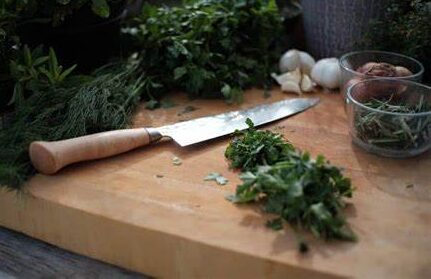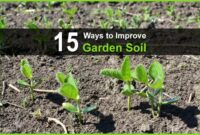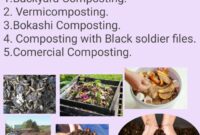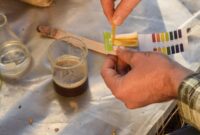Growing Herbs Indoors – Indoor herb gardening has become increasingly popular for home chefs, apartment dwellers, and plant lovers alike. With just a bit of space, light, and care, you can grow fresh, fragrant herbs right on your windowsill, providing easy access to ingredients and a touch of greenery all year long. This guide will walk you through the essentials for growing herbs indoors, covering the best herbs to grow, how to set up your indoor herb garden, and tips to keep your plants thriving.
Table of Contents
ToggleWhy Grow Herbs Indoors?
Growing herbs indoors is not only convenient but also incredibly rewarding. Here are a few reasons why many people are choosing to start an indoor herb garden:
- Fresh Flavor Year-Round: Unlike seasonal outdoor gardens, indoor herbs can grow continuously, offering fresh herbs like basil, thyme, and mint any time you need them.
- Easy Access: Having herbs on your kitchen counter or windowsill means you can quickly grab a sprig for cooking without needing to run outside.
- Aesthetic Appeal: Herbs add a touch of greenery to any indoor space, brightening up your kitchen and bringing nature indoors.
- Aromatherapy: The scents of lavender, rosemary, and oregano are not only useful for cooking but can also fill your home with natural fragrances.
Best Herbs to Grow Indoors
Some herbs grow better indoors than others, especially when sunlight and temperature are limited. Here’s a list of popular, beginner-friendly herbs that are ideal for an indoor herb garden:
- Basil: A favorite in kitchens for its vibrant taste, basil thrives in warm temperatures and plenty of sunlight.
- Thyme: Hardy and versatile, thyme is easy to grow and doesn’t require frequent watering.
- Mint: Known for its refreshing flavor, mint can handle low light but can grow aggressively, so it’s best kept in a separate container.
- Oregano: Perfect for Italian dishes, oregano loves the sun and can adapt to indoor life well.
- Rosemary: Aromatic and woody, rosemary prefers lots of sunlight and can be pruned regularly to maintain shape.
- Parsley: With its fresh, slightly bitter taste, parsley is great for salads and soups and can tolerate indirect sunlight.
Essential Tips for Indoor Herb GardeningTo ensure success in your indoor herb garden, it’s crucial to provide the right conditions. Here are some essential tips for growing herbs indoors:
- Light: Most herbs require 6-8 hours of sunlight each day. If natural light is insufficient, consider using a grow light to supplement.
- Watering: Overwatering is a common mistake. Herbs need soil that drains well; check moisture levels before watering, and let the soil dry out slightly between watering.
- Temperature and Humidity: Herbs generally prefer temperatures between 65-75°F (18-24°C). Avoid placing them near heating vents or drafty windows.
- Soil: Use a well-draining, high-quality potting mix specifically for herbs or vegetables. Good drainage is essential for healthy root development.
- Containers: Ensure pots have drainage holes to prevent root rot. For best results, use containers that are about 6-8 inches deep.
Setting Up Your Indoor Herb Garden
Creating a dedicated space for your herbs can enhance their growth and make it easier for you to care for them. Follow these steps to set up a simple yet effective indoor herb garden:
- Choose a Sunny Spot: Find a south-facing window where your herbs will receive the most natural light. A windowsill, kitchen counter, or even a small plant stand near a window works well.
- Group Similar Plants: Group herbs with similar light and water needs. For example, basil and rosemary both need ample light, while mint and parsley can tolerate less.
- Add a Grow Light: If your space doesn’t get enough natural light, a grow light can mimic sunlight, allowing your herbs to thrive. LED grow lights are energy-efficient and effective for indoor plants.
- Rotate Plants: Rotate your plants every few days so that all sides get exposure to light, helping them grow evenly.
- Prune Regularly: Regular harvesting and pruning encourage bushy growth. For example, pinch off basil leaves from the top to prevent flowering and keep the plant productive.
Common Challenges and Solutions
Indoor herb gardening can be easy, but some common issues may arise. Here are solutions to typical challenges:
- Insufficient Light: If herbs become leggy and pale, they might need more light. Try moving them to a sunnier spot or using a grow light.
- Overwatering: Drooping or yellow leaves can indicate overwatering. Adjust your watering schedule and check for drainage issues.
- Pests: Indoor herbs can sometimes attract pests like aphids and spider mites. Try washing leaves gently with water or using a mild, organic insecticidal soap.
Conclusion
Growing herbs indoors is a simple, rewarding project that offers fresh flavors, beautiful greenery, and fragrant aromas year-round. By choosing the right herbs and providing the right conditions, you can enjoy a thriving indoor herb garden in no time. Whether you’re a seasoned gardener or a beginner, indoor herb gardening is accessible to all, adding a green touch to your home and a fresh twist to your meals.
For more tips on indoor gardening and herbs, check out this helpful guide from the National Gardening Association, which offers more in-depth information on plant care and troubleshooting.




